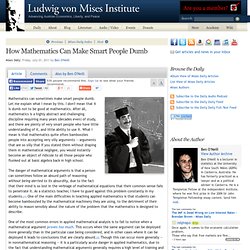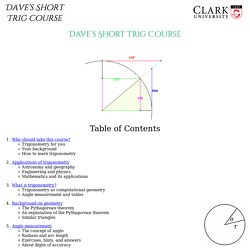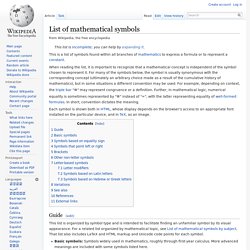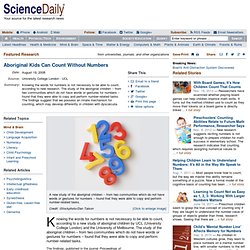

How Mathematics Can Make Smart People Dumb - Ben O'Neill. Mathematics can sometimes make smart people dumb.

Let me explain what I mean by this. I don't mean that it is dumb not to be good at mathematics. After all, mathematics is a highly abstract and challenging discipline requiring many years (decades even) of study, and there are plenty of very smart people who have little understanding of it, and little ability to use it. What I mean is that mathematics quite often bamboozles people into accepting very silly arguments — arguments that are so silly that if you stated them without draping them in mathematical negligee, you would instantly become an object of ridicule to all those people who flunked out at basic algebra back in high school.
The danger of mathematical arguments is that a person can sometimes follow an absurd path of reasoning without being alerted to its absurdity, due to the fact that their mind is so lost in the verbiage of mathematical equations that their common sense fails to penetrate it. But wait a minute. Notes. Dave's short course in trigonometry. Table of Contents Who should take this course?

Trigonometry for you Your background How to learn trigonometry Applications of trigonometry Astronomy and geography Engineering and physics Mathematics and its applications What is trigonometry? Trigonometry as computational geometry Angle measurement and tables Background on geometry The Pythagorean theorem An explanation of the Pythagorean theorem Similar triangles Angle measurement The concept of angle Radians and arc length Exercises, hints, and answers About digits of accuracy Chords What is a chord?
Ptolemy’s sum and difference formulas Ptolemy’s theorem The sum formula for sines The other sum and difference formulas Summary of trigonometric formulas Formulas for arcs and sectors of circles Formulas for right triangles Formulas for oblique triangles Formulas for areas of triangles Summary of trigonometric identities More important identities Less important identities Truly obscure identities About the Java applet. Introduction to Algorithms - Download free content from MIT.
We come from the future. List of mathematical symbols. When reading the list, it is important to recognize that a mathematical concept is independent of the symbol chosen to represent it.

For many of the symbols below, the symbol is usually synonymous with the corresponding concept (ultimately an arbitrary choice made as a result of the cumulative history of mathematics), but in some situations a different convention may be used. For example, depending on context, the triple bar "≡" may represent congruence or a definition. Further, in mathematical logic, numerical equality is sometimes represented by "≡" instead of "=", with the latter representing equality of well-formed formulas. In short, convention dictates the meaning.
Each symbol is shown both in HTML, whose display depends on the browser's access to an appropriate font installed on the particular device, and in TeX, as an image. Guide[edit] This list is organized by symbol type and is intended to facilitate finding an unfamiliar symbol by its visual appearance. Basic symbols[edit] Australian Aboriginal enumeration. The Australian Aboriginal counting system was used to send messages on message sticks to neighbouring clans to alert them of, or invite them to, corroborees, set-fights, and ball games.

Numbers could clarify the day the meeting was to be held (in a number of "moons") and where (the number of camps' distance away). The messenger would have a message "in his mouth" to go along with the message stick. A common misconception among non-Aboriginals is that Aboriginals did not have a way to count beyond two or three. However, Alfred Howitt, who studied the peoples of southeastern Australia, disproved this in the late nineteenth century, although the myth continues in circulation today. The systems below are those of the Wurundjeri (Howitt called them after their language, Woiwurung) and the Wotjoballuk. Wurundjeri counting system[edit] Wotjoballuk counting system[edit] Note that both numbers 6 and 8 here appear to be represented by the elbow. Other languages[edit] See also[edit] References[edit] Aboriginal Kids Can Count Without Numbers. Knowing the words for numbers is not necessary to be able to count, according to a new study of aboriginal children by UCL (University College London) and the University of Melbourne.

The study of the aboriginal children – from two communities which do not have words or gestures for numbers – found that they were able to copy and perform number-related tasks. The findings, published in the journal Proceedings of the National Academy of Sciences, suggest that we possess an innate mechanism for counting, which may develop differently in children with dyscalculia.
Professor Brian Butterworth, lead author from the UCL Institute of Cognitive Neuroscience, says: “Recently, an extreme form of linguistic determinism has been revived which claims that counting words are needed for children to develop concepts of numbers above three. That is, to possess the concept of ‘five’ you need a word for five. “Thus, basic numerical concepts do indeed appear to depend on an innate mechanism. Numeral Systems of the World's Languages.